After we left the Suffolk Punch Trust we drove a couple of miles to Shingle Street on the coast.
I wanted to visit this beach to look at the plants and flowers that live on the shingle. I had heard that it was a desolate spot but when we were there the place was teeming with kite-surfers!

Shingle Street Part of the beach was fenced off to protect nesting birds, little terns and ringed plovers, and to protect this beach from damage by trampling.

Looking south towards the Martello Tower
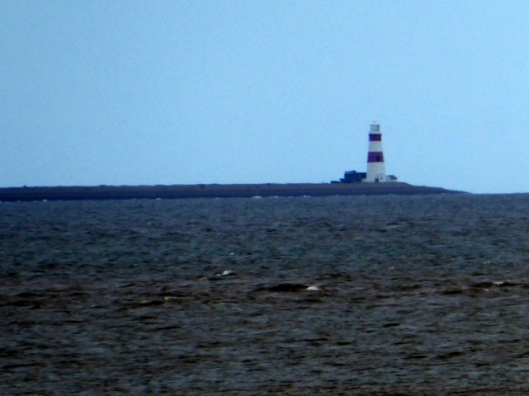
Looking north towards Orfordness lighthouse….
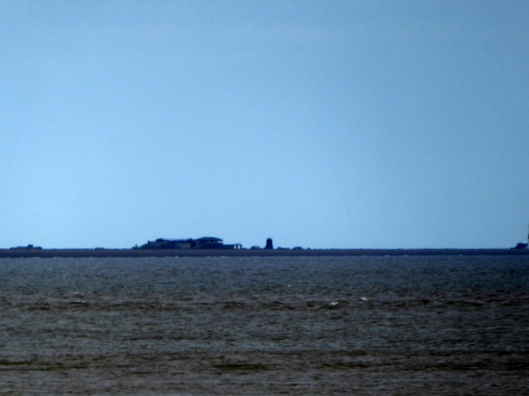
…and the old atomic weapons research establishment
The name ‘Bugloss’ derives from the Greek for ‘ox-tongued’ – the plant is quite rough and bristly to the touch. Parts of the plant are also thought to look like a snake – the fruits, which are said to resemble an adder’s head, used to be used to cure snake bites even though the plant is poisonous!
According to my field guide, the flowers are honey-scented when fresh and smell of new-mown hay when dry. In days gone by, it was said to discourage fleas and so was added to straw mattresses especially for the beds of women about to give birth.
I was very pleased to see this plant still in flower! Usually I find it too late to admire the bright pink flowers. It is a nationally scarce plant but where it is happy it grows well and plentifully. My field guide tells me that the seed pods resemble garden pea-pods and were eaten (apparently) in Suffolk in times of famine (e.g. 1555). The pods are toxic in large quantities.
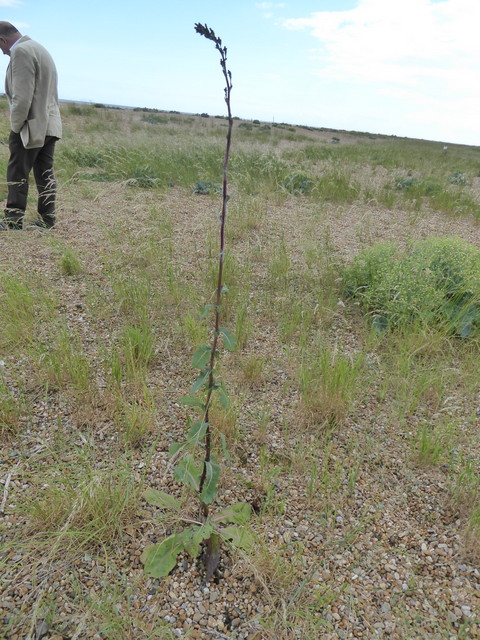
Prickly Lettuce (Lactuca serriola) These plants can grow as tall as 200 cm/ 6.5 ft. Prickly lettuce is a non-native and was first recorded here in 1632.
This visit to the Shingle Street beach was a very pleasant end to an enjoyable day.
Thanks for visiting!
Harrap’s Wild Flowers: Simon Harrap

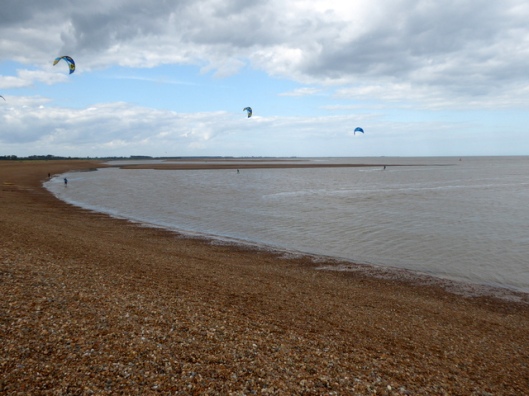

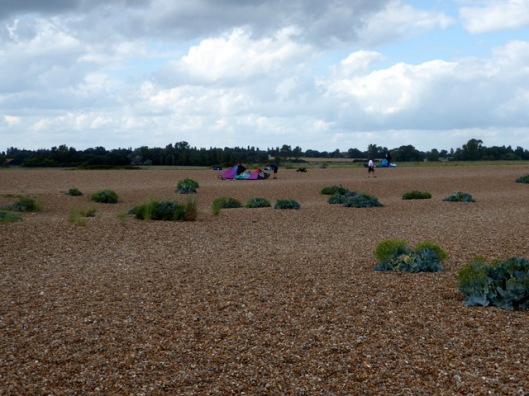
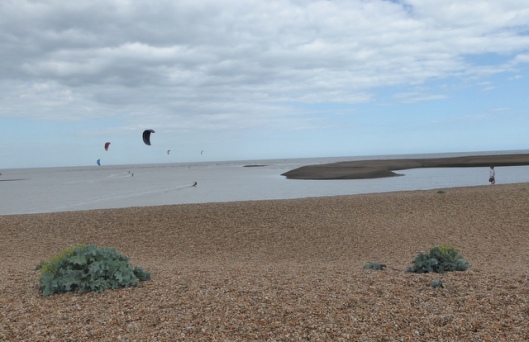
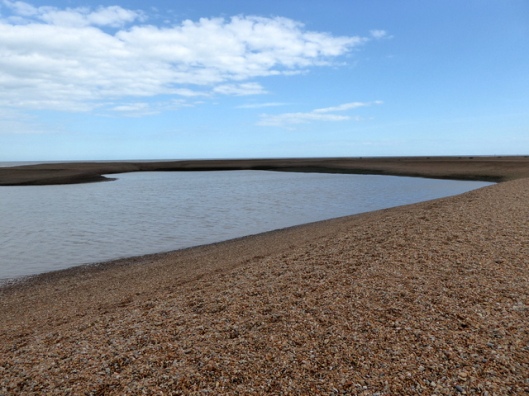


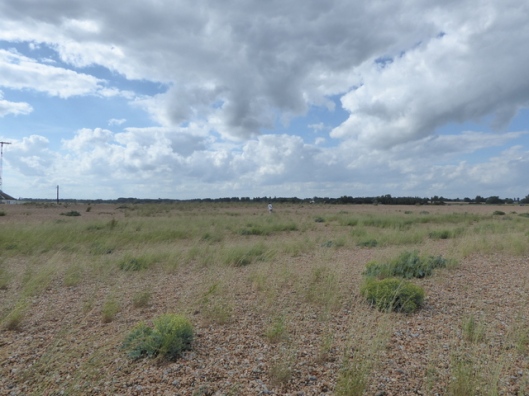


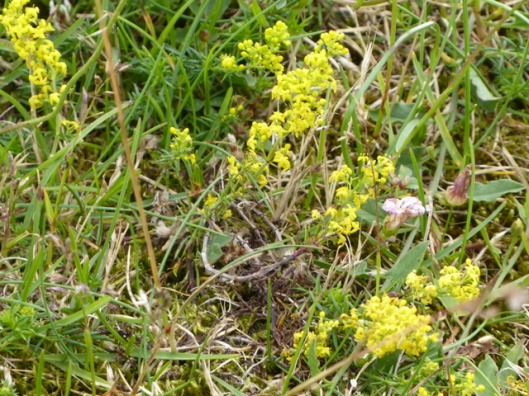


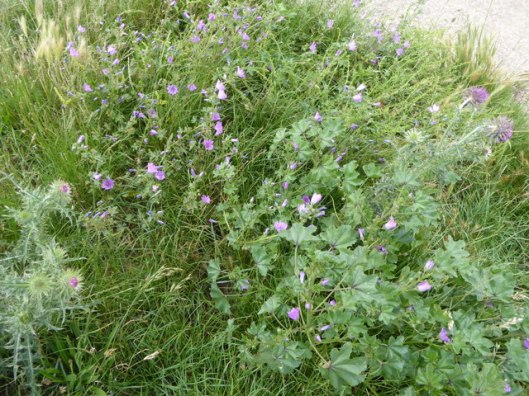


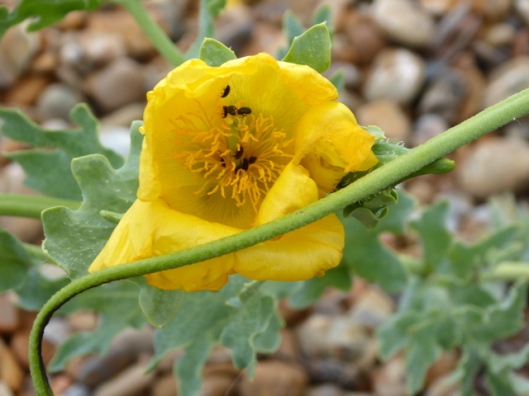
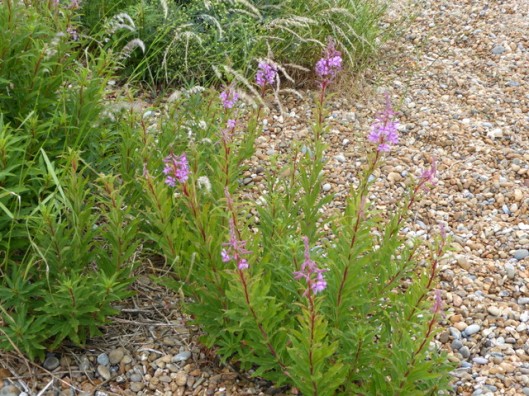
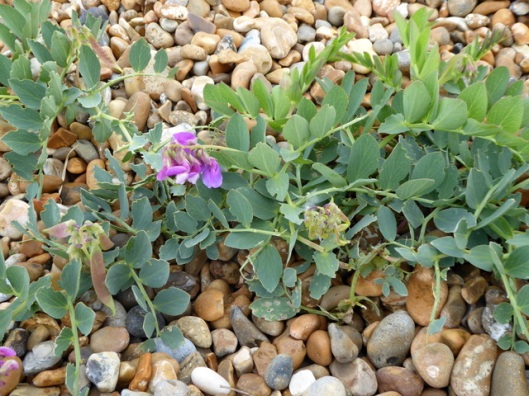

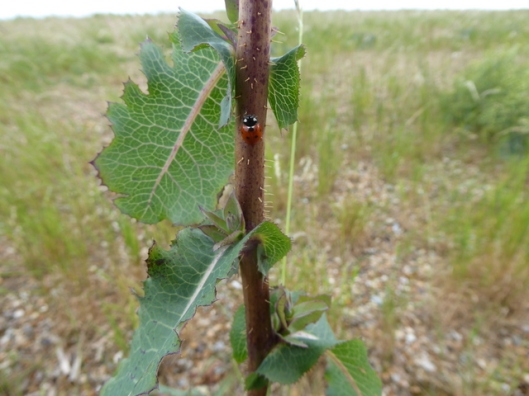
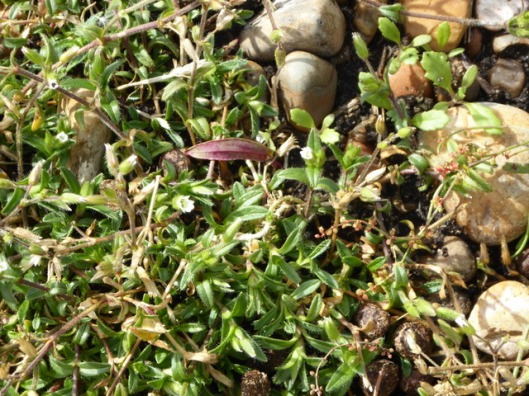
First time I’ve ever seen sea kale. Is it edible ?
LikeLiked by 1 person
Yes it is, though I’ve never had any. It was always eaten by people living near the coast but it was ‘discovered’ in the 19th century and became so popular that it nearly disappeared altogether. It is doing okay now but we are encouraged not to harvest it from the beach. Seeds can be bought so it can be grown at home.
http://www.plantlife.org.uk/wild_plants/plant_species/sea_kale
LikeLiked by 1 person
So many stunning photographs, Clare. The Prickly Lettuce looks so lonely sprouting in the empty field. Is that a type of weed? I loved the Spear Thistle too! Not sure about the kite surfing, the water looks a bit chilly. Thanks for taking us along! ❤
LikeLiked by 1 person
Thank-you Jill. Yes the Prickly Lettuce is a weed and it’s a non-native too.
The kite-surfers are a hardy lot, like anyone who takes part in water-sports in this country. They wear wet-suits so they don’t freeze!
LikeLiked by 1 person
It still looks too cold! Brr….
LikeLiked by 1 person
😀 xx
LikeLiked by 1 person
I’m sorry to say… I’m not familiar to any of these plants shown on your post! Thank you Clare, you have a great eye for identifying each one of them I might learn from you. 🙂
LikeLiked by 1 person
Thank-you HJ! 🙂
LikeLiked by 1 person
Enjoyed your visit to this unusual beach.
LikeLiked by 1 person
Thank-you Susan.
LikeLike
I love East Anglian beaches with their profusion of interesting plants. Thanks for taking us there!
LikeLiked by 1 person
Thank-you very much, Margaret!
LikeLiked by 1 person
Lovely post Clare, I haven’t been to Shingle Street before, it looks breezy! Although I’ve looked at Martello tower on the Landmark Trust website and had thought that was in Aldeburgh for some reason. I have Simon Harrap’s book too, its my favourite wildflower resource.
LikeLiked by 1 person
Thank-you Julie. There is a Martello tower at Aldeburgh as well as the one at Hollesley. Also 4 in Felixstowe and 2 at Bawdsey.
I have recently bought myself the Harrap. It’s the best one I’ve ever used and so beautiful too. I think you recommended it to me last year!
LikeLiked by 1 person
I love that lagoon, set apart from the wild sea! You do have such interesting outings, Clare!
LikeLiked by 1 person
Thank-you Kerry. The lagoon is ideal and safe for swimming in, though the water is quite cold! I’m not sure if the lagoon is still there after the tidal surge a few weeks ago; I’ll have to go back sometime.
LikeLike
What an empty looking beautiful place. Thanks for the details about the plants. I’m. glad that snake bite treatment has moved on.
LikeLiked by 1 person
Kill or cure! I’m glad things have moved on a bit since then too! Thanks Rachel.
LikeLike
I was surprised at the familiar names of many of the plants you mentioned here; I’m not much of an expert at wild flowers anywhere!
I’ve often wondered at the fragrance of the ladies’ bedstraw, but I haven’t ever been near it. It must be nice.
LikeLiked by 1 person
Thank-you Lisa. I have found Lady’s Bedstraw a few times in the past couple of years but don’t remember ever having seen it before that. I don’t have a good sense of smell because of the inhalers I use for asthma so I couldn’t say whether the description is correct.
LikeLike
Fascinating, Clare – what a wonderful place. Have you ever visited Derek Jarman’s cottage at Dungeness in Kent? It is somewhere I have always wanted to go, and your pictures reminded me of it very much. Of course, we are these days a rather long way from Kent, so not sure whether I will ever make it – it’s not even on the way to anything…! 🙂
LikeLiked by 1 person
Thank-you LIz. I have wanted to see Derek Jarman’s cottage too, but never have. I have been to that part of the Kent coast a number of times before but never to Dungeness; maybe one day….
LikeLiked by 1 person
Indeed! You never know 🙂
LikeLiked by 1 person
🙂
LikeLike
Very nice thistle picture. That beach looked like a very good place to be even on such a windy day.
LikeLiked by 1 person
Thank-you Tom. It was a good place to be but because of the wind we didn’t stay too long!
LikeLiked by 1 person
I love the color of the viper’s bugloss. It looks like it would make a great garden plant.
I’ve seen plenty of lady’s bedstraw but never in the wild.
I’ve never heard of the sea beet or the sea pea. Both look and sound interesting.
I wonder why anyone would have imported prickly lettuce. It’s also called opium lettuce. I wonder if they smoked it.
That looks like the kind of place you could spend days exploring, and I’d love to.
LikeLiked by 1 person
Thank-you Allen. Viper’s bugloss is one of my favourite plants; I love blue flowers! One day I hope to have a little more time to take better more detailed photos of flowers. I’m always so rushed, trying to keep up with the people I’m with. The sea beet is a very close relative of the sugar beet that is grown everywhere here but doesn’t have the swollen root that is harvested for sugar production and animal feed. I can’t imagine why anyone would have wanted to import the prickly lettuce either unless it was good to smoke! It was probably one of those accidental imports that arrived with something else.
LikeLiked by 1 person
I found one small plant of viper’s bugloss in my wildflower garden this summer. I was delighted. Viper’s bugloss honey is one of my favourite honey flavours.
LikeLiked by 1 person
After I saw it at Shingle Street I thought how gorgeous it would be to have it in my garden. I will try to find seeds this year.
LikeLiked by 1 person
It may be a bit invasive. I don’t know. But the bees love it.
LikeLiked by 1 person
That’s all that matters to me!
LikeLiked by 1 person
Me, too.
LikeLiked by 1 person
Some fantastic flowers there – Suffolk is such a lovely place.
LikeLiked by 1 person
Thank-you Simon! Lovely in parts.
LikeLiked by 1 person
Looking at the wonderful landscape photos of the area I wouldn’t have thought that so many flowers would be found there. The only flower that I recognized was the seat pea, it is abundant here. The others were all new to me, and I can see why you made the trip there to see them as beautiful as they are.
LikeLiked by 1 person
Thank-you Jerry. It is a very fragile landscape as a storm and high tide can do a lot of damage.
LikeLiked by 1 person
Sea Kale…I had kale last night, I wonder if that was from the sea or the um, standard kind. There is something mysterious about the lighthouse too, its as equally enticing as that church…how I love your wanderings!
LikeLiked by 1 person
Thank-you so much Ste! You probably had the standard kale; sea kale’s not often available unless you forage for it, grow it yourself or frequent very expensive restaurants. I don’t do any of those and I’ve never eaten it myself.
LikeLiked by 1 person
I am too lazy and cheap to do any of those things haha. Although the $47 dollar steak in Boston was a highlight!
LikeLiked by 1 person
It’s so nice to see such colorful flowers in the middle of a snowy winter. I love the kite surfers too. They’re always fun to watch, especially when they start flying through the air.
LikeLiked by 1 person
Thank-you Sheila. I love to watch them but I haven’t the courage to try it myself!
LikeLiked by 1 person
Such beautiful landscape and some really pretty wildflowers too. I always love the history behind the names of places. Was there actually a street covered in shingle or is the beach so flat that it was used as a means of travel I wonder?
LikeLike
Thank you Kate. I believe ‘Street’ is often used in Suffolk as a village name or to describe part of a village. I used to live in a village called Rumburgh and the part of the village I lived in was Rumburgh Street. Sometimes ‘Straight’ is substituted for ‘Street’ as quite often the village is just a row of houses along a straight road and sometimes it is an old Roman road.
LikeLiked by 1 person
Oh that is fascinating – I never realised that. Thank you for the info!
LikeLiked by 1 person
My pleasure.
LikeLike
Claire, sorry to have missed these posts! A beautiful visit to Shingle Street, and loved all the photos. I remember kite surfing down by the sea as a youngster.
LikeLiked by 1 person
No need to apologise Lavinia, and thank-you! I hope you are well?
LikeLiked by 1 person
A few minor adjustments made in January, but doing much better now. 🙂
LikeLiked by 1 person
I am pleased!
LikeLiked by 1 person
Absolutely fascinating. I have never been to Shingle Street and I am glad to see some shots of it – it’s a place that has intrigued me since a boy. I think I first heard of it via a Dennis Wheatley novel, ‘Black August’. Did pop into Orford Ness last year, though – so that will appear on ABAB at some point. Love all your shots of the plants – and totally impressed, as always!
LikeLiked by 1 person
Thanks very much Mike. There are a few strange, (apocryphal?) stories involving Shingle Street during the Second World War. It is certainly a bleak and isolated spot (except for the kite surfers!)
LikeLike
Amazing to see so much thriving on shingle. 🙂
LikeLiked by 1 person
It really is very surprising how many plants seem to thrive on this seemingly barren terrain.
LikeLiked by 1 person